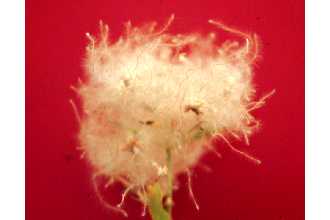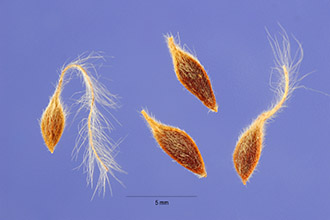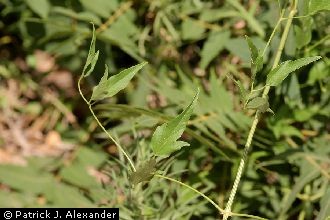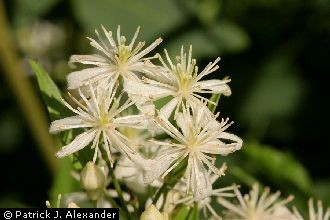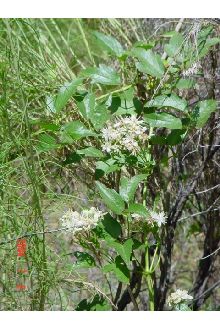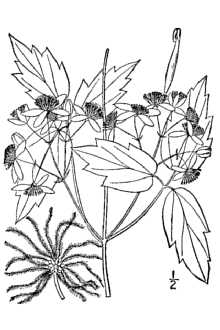Western White Clematis
Scientific Name: Clematis ligusticifolia Nutt.
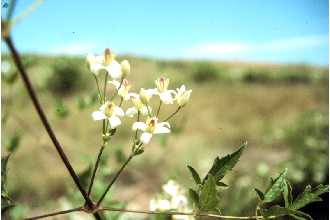
| General Information | |
|---|---|
| Usda Symbol | CLLI2 |
| Group | Dicot |
| Life Cycle | Perennial |
| Growth Habits | Vine |
| Native Locations | CLLI2 |
Plant Guide
Alternate Names
white clematis, virgin’s-bower, traveler’s joy, leatherflower
Uses
Erosion control/reclamation/landscape: Western clematis has great potential to improve roadsides and other dryland critical areas even though it typically occurs in riparian and run-on areas. It is very drought tolerant and transplants have performed very well in trials conducted on sites that receive as little as 7 inches of annual precipitation (Pullman PMC 1993). Placing plants along the top of a cut will allow the canopy to drape over the bare soil and effectively protect the soil. If allowed to climb fences, it will slow soil and catch tumbleweeds. Western clematis can provide excellent stabilization of intermittent streambanks because it does not require as much moisture as many other riparian plants. The stems develop a thick mat that effectively protect streambank soils and may deter livestock movement. The landscape value of western clematis is apparent in xeriscaping projects. It remains green late throughout the growing season and the leaves drop in late-fall. The dense leaf canopy can effectively shield background objects that the landscaper wishes to remain unseen. The flowers are smaller then hybrid floral varieties but the plumed seedheads are very attractive. Grazing/rangeland/wildlife: Western clematis has limited grazing value. Sheep will utilize the young tender leaves. Western clematis is occasionally grazed by cattle and rarely by horses (USDA Forest Linda Turrey USDA NRCS Pullman PMC Service Range Plant Handbook). Use by large game is probably limited. Small birds and rodents use the canopy for cover. Ethnobotany: The root of western clematis was used as a horse stimulant by Native Americans. The root was scraped and placed in the nostrils of fallen, exhausted horses. The fallen horse would jump to its feet and then be led to water. Native Americans also chewed the plant to remedy colds and sore throats. Just touching the scraped root to the tongue causes a burning sensation that lasts for ½ day (Geyer 1846).
Status
This is a native species. Consult the PLANTS Web site and your State Department of Natural Resources for this plant’s current status, such as state noxious status and wetland indicator values.
Description
General: Buttercup Family (Ranuculaceae). Western clematis is a deciduous, perennial vine. Stems grow from the crown and are numerous in hospitable environments. They generally die back each winter, but the first 1-5 m generally persist for several years. Stems may be as long as 20 m in length (Hitchcock et al 1964). The leaves are pinnately compound and are dropped in late fall. It is dioecious and the flowers are white. Flowers first appear in late June and continue through August. Seedheads are very showy and resemble tufts of goose down. A taproot effectively anchors Western clematis to the soil.
Distribution
Hitchcock et al, Use soil moisture sensors to measure the soil moisture of Western White Clematis., (1964) described the distribution of western clematis as southern British Columbia, south to California, east to the Dakotas and west to both sides of the Oregon Cascades, For current distribution of this species and its relatives, consult the Plant Profile page for this species on the PLANTS Web site,
Adaptation
Cold Hardiness Zone: 5a-7a. Mean Annual Precipitation: 230-530mm (9-21 in.) Elevation: 150-1375m (500-4500 ft.) MLRA: 6, 8, 9, 10, 11, 12, 23, 24, 25, 43, and 44 Soil: Silt loams and other medium-textured soils Western clematis is common in open Ponderosa pine (Pinus ponderosa) and big sage (Artemisia tridentata) riparian areas. It is also common in run-on areas such as railroad fills that impound water for a few weeks during the spring. It is partially shade tolerant and can be found in stands of alder. Full shade that occurs under stands of tall evergreen trees is less hospitable. It grows well in full sun. Soils must be relatively deep with good water holding capacity. Shallow soils or deep soils that cannot supply/retain water during the summer months do not support western clematis. Species often associated with western clematis include the following: the big sagebrush (Artemisia tridentata) complex, Ponderosa pine (Pinus ponderosa), alder (Alnus rhombifolia), juniper (Juniperus spp.), Woods rose (Rosa woodsii.), Douglas hawthorn (Crataegus Douglasii), chokecherry (Prunus virginiana), redosier dogwood (Cornus stolonifera), bluebunch wheatgrass (Pseudoroegneria spicata), sand dropseed (Sporobolus airoides), Snake River wheatgrass (Elymus wawawaiensis), Sandberg bluegrass (Poa secunda), needle-and-thread (Nassella comata), and Idaho fescue (Festuca idahoensis).
Establishment
Seeding: Western clematis is generally not seeded. Seeding is impractical because germination is far too slow in the field. A minimum of 12 days of favorable moisture and temperature is required for good levels of germination. Further complicating seeding is the long-fuzzy style, which is very difficult to remove from the seed. Standard reclamation drills and broadcast seeders are not capable of handling clematis seed with the stylus intact. Transplanting: Rooted plants are easily transplanted. The soil should be at least 75% of field capacity at planting. Mulching or erecting a small shade (flat rock turned on end or similar structure) reduces evaporative loss and improves survival. Weed barrier cloth can be used to reduce competition and improve survival. Once fully established, western clematis is very persistent.
Management
Western clematis is a relatively low maintenance plant once established. Competition should be controlled the first year. Observations have shown that plants withstand severe defoliation and even crown damage. While grazing is not a major concern, trampling can be detrimental so plants should be protected until well established. Mark Stannard USDA NRCS Pullman PMC Seedhead of western clematis. Mulching under the plant improves layering. Vines can be cut back each year or allowed to accumulate. Digging plants is not advised because it is difficult to extract a large enough portion of the root to support the plant. Removing plants in the wild may also severely disturb the site and leave it especially prone to weed invasion. It is a climbing vine so it should not be planted immediately adjacent to structures where it will be a problem. Unwanted plants can be controlled via mechanical removal and/or application of appropriate herbicides. Allow 2 years for good control because the plant may regrow from the root.
Environmental Concerns
Concerns
Concerns
Western clematis is long-lived, spreads primarily via seed in the wild, but also via vegetative means (layering). It is not considered to be a "weedy" or invasive species, but can spread into adjoining vegetative communities under ideal climatic and environmental conditions. Some consider this to be an undesirable trait particularly in riparian zones where it may cover associated shrubby vegetation.
Propagation
Seeding: Most clematis species generally require 60 to 180 days of cold stratification to initiate germination (USDA, 1974). However, western clematis seeds do not require prolonged stratification, and high levels of germination can be achieved by soaking the seeds for 48-hours in a 0.001M solution of giberellic acid or de-ionized water (Pullman PMC, 1982). Seed should be planted to containers that allow for long, dense roots. Well-rooted plants develop in roughly 10 weeks. Softwood Propagation: Western clematis is easily propagated via softwood cuttings and is the preferred propagation method. Cuttings require a leaf bud and typically root in 15-20 days. Cuttings are treated with 3000 ppm I.B.A. rooting hormone and placed in a misting chamber with bottom heat. Well-rooted plants develop in roughly 10 weeks. Hardwood Propagation: Western clematis can be rooted via hardwood cuttings. Obtaining good quality cuttings varies from year to year depending on previous year growing conditions. Treating the cutting with a 3000 ppm I.B.A. rooting hormone and placing the cuttings in a cool-dark environment improves rooting. Rooting success as high as 76% can be obtained. Placing the treated cuttings in a misting chamber with bottom heat is an alternative and rooting is more rapid. Cultivars, Improved and Selected Materials (and area of origin) 'Trailar' western clematis was selected by the Pullman Plant Materials Center and released in 1992. It was selected from native collections made in Walla Walla and Benton Counties, Washington. It is recommended for use as a soil cover in intermittent dryland stream corridors; for roadside and other erosion prone sites; as ground cover for small mammals and upland birds; and as screening or landscape plant, particularly where a native is desired. Rooted clonal-plants are available to nurseries and researchers in limited quantities from the Pullman Plant Materials Center. Seed is not available. Contact your local Natural Resources
Conservation
Service (formerly Soil Conservation Service) office for more information. Look in the phone book under ”United States Government.” The Natural Resources Conservation Service will be listed under the subheading “Department of Agriculture.”
References
Geyer, C.A. 1846. Notes on the vegetation and general character of the Missouri and Oregon Territories, made during a botanical journey in the state of Missouri, across the South Pass of the Rocky Mountains, to the Pacific, during the years 1843 and 1844. London J. Bot. 5:285-310. Hitchcock, C.L., A. Cronquist, M. Ownbey, and J.W. Thompson 1964. Vascular plants of the Pacific Northwest. University of Washington Press, Seattle, Washington. USDA, Forest Service 1937. Range Plant Handbook. USDA, Forest Service 1974. Seeds of woody plants in the United States. Agr. Handbook #450, Washington, DC. USDA, NRCS. 1982. Pullman Plant Materials Center Annual Technical Report, Pullman, Washington. USDA, NRCS. 1993. Pullman Plant Materials Center Annual Technical Report, Pullman, Washington. USDA, NRCS. 2003. The PLANTS database. Version: 030106. <http://plants.usda.gov>. National Plant Data Center, Baton Rouge, Louisiana.
Plant Traits
Growth Requirements
| Cold Stratification Required | No |
|---|---|
| Hedge Tolerance | None |
| Hedge Tolerance | Medium |
| Frost Free Days, Minimum | 120 |
| Frost Free Days, Minimum | 120 |
| Fire Tolerance | Medium |
| Fire Tolerance | Medium |
| Fertility Requirement | Medium |
| Fertility Requirement | Medium |
| Drought Tolerance | Medium |
| Drought Tolerance | Medium |
| Cold Stratification Required | Yes |
| Temperature, Minimum (°F) | -38 |
| CaCO3 Tolerance | Low |
| CaCO3 Tolerance | Low |
| Anaerobic Tolerance | None |
| Anaerobic Tolerance | None |
| Adapted to Medium Textured Soils | Yes |
| Adapted to Medium Textured Soils | Yes |
| Adapted to Fine Textured Soils | Yes |
| Adapted to Fine Textured Soils | No |
| Adapted to Coarse Textured Soils | Yes |
| Adapted to Coarse Textured Soils | Yes |
| Moisture Use | Medium |
| Temperature, Minimum (°F) | -23 |
| Shade Tolerance | Intermediate |
| Shade Tolerance | Intermediate |
| Salinity Tolerance | Low |
| Salinity Tolerance | Low |
| Root Depth, Minimum (inches) | 16 |
| Root Depth, Minimum (inches) | 16 |
| Precipitation, Minimum | 12 |
| Precipitation, Minimum | 12 |
| Precipitation, Maximum | 20 |
| Precipitation, Maximum | 20 |
| Planting Density per Acre, Minim | 1200 |
| Planting Density per Acre, Minim | 1200 |
| Planting Density per Acre, Maxim | 4800 |
| Planting Density per Acre, Maxim | 4800 |
| pH, Minimum | 5.6 |
| pH, Minimum | 5.6 |
| pH, Maximum | 8.4 |
| pH, Maximum | 8.4 |
| Moisture Use | Medium |
Morphology/Physiology
| Active Growth Period | Spring and Summer |
|---|---|
| Toxicity | None |
| Toxicity | None |
| Fire Resistant | No |
| Foliage Texture | Medium |
| Foliage Porosity Winter | Porous |
| Foliage Porosity Winter | Porous |
| Foliage Porosity Summer | Moderate |
| Foliage Porosity Summer | Moderate |
| Foliage Color | Green |
| Foliage Color | Green |
| Flower Conspicuous | Yes |
| Flower Conspicuous | Yes |
| Flower Color | White |
| Flower Color | White |
| Shape and Orientation | Climbing |
| Fire Resistant | No |
| Fall Conspicuous | No |
| Fall Conspicuous | No |
| Coppice Potential | No |
| Coppice Potential | No |
| C:N Ratio | Medium |
| C:N Ratio | Medium |
| Bloat | None |
| Bloat | None |
| Active Growth Period | Spring and Summer |
| Shape and Orientation | Climbing |
| Fruit/Seed Color | White |
| Resprout Ability | Yes |
| Resprout Ability | Yes |
| Nitrogen Fixation | None |
| Nitrogen Fixation | None |
| Low Growing Grass | No |
| Low Growing Grass | No |
| Lifespan | Long |
| Lifespan | Long |
| Leaf Retention | No |
| Leaf Retention | No |
| Known Allelopath | No |
| Height, Mature (feet) | 1.0 |
| Known Allelopath | No |
| Foliage Texture | Medium |
| Fruit/Seed Color | White |
| Fruit/Seed Conspicuous | No |
| Fruit/Seed Conspicuous | No |
| Growth Form | Multiple Stem |
| Growth Form | Multiple Stem |
| Growth Rate | Moderate |
| Growth Rate | Moderate |
| Height, Mature (feet) | 1.0 |
Reproduction
| Propagated by Cuttings | Yes |
|---|---|
| Propagated by Seed | Yes |
| Propagated by Seed | Yes |
| Propagated by Sod | No |
| Propagated by Sod | No |
| Propagated by Sprigs | No |
| Propagated by Sprigs | No |
| Propagated by Tubers | No |
| Propagated by Tubers | No |
| Seed per Pound | 314000 |
| Fruit/Seed Period End | Fall |
| Seed per Pound | 314000 |
| Seed Spread Rate | Slow |
| Seed Spread Rate | Slow |
| Seedling Vigor | Medium |
| Seedling Vigor | Medium |
| Small Grain | No |
| Small Grain | No |
| Vegetative Spread Rate | Moderate |
| Vegetative Spread Rate | Moderate |
| Propagated by Corm | No |
| Propagated by Cuttings | Yes |
| Bloom Period | Mid Summer |
| Bloom Period | Mid Summer |
| Commercial Availability | Routinely Available |
| Commercial Availability | Routinely Available |
| Fruit/Seed Abundance | Low |
| Fruit/Seed Abundance | Low |
| Fruit/Seed Period Begin | Summer |
| Fruit/Seed Period Begin | Summer |
| Fruit/Seed Period End | Fall |
| Fruit/Seed Persistence | Yes |
| Propagated by Bare Root | Yes |
| Propagated by Bare Root | Yes |
| Propagated by Bulb | No |
| Propagated by Bulb | No |
| Propagated by Container | Yes |
| Propagated by Container | Yes |
| Propagated by Corm | No |
| Fruit/Seed Persistence | Yes |
Suitability/Use
| Palatable Browse Animal | Low |
|---|---|
| Palatable Graze Animal | Low |
| Palatable Graze Animal | Low |
| Palatable Human | No |
| Palatable Human | No |
| Post Product | No |
| Post Product | No |
| Protein Potential | Low |
| Protein Potential | Low |
| Pulpwood Product | No |
| Pulpwood Product | No |
| Veneer Product | No |
| Veneer Product | No |
| Palatable Browse Animal | Low |
| Nursery Stock Product | Yes |
| Nursery Stock Product | Yes |
| Naval Store Product | No |
| Naval Store Product | No |
| Lumber Product | No |
| Lumber Product | No |
| Fodder Product | No |
| Fodder Product | No |
| Christmas Tree Product | No |
| Christmas Tree Product | No |
| Berry/Nut/Seed Product | No |
| Berry/Nut/Seed Product | No |

